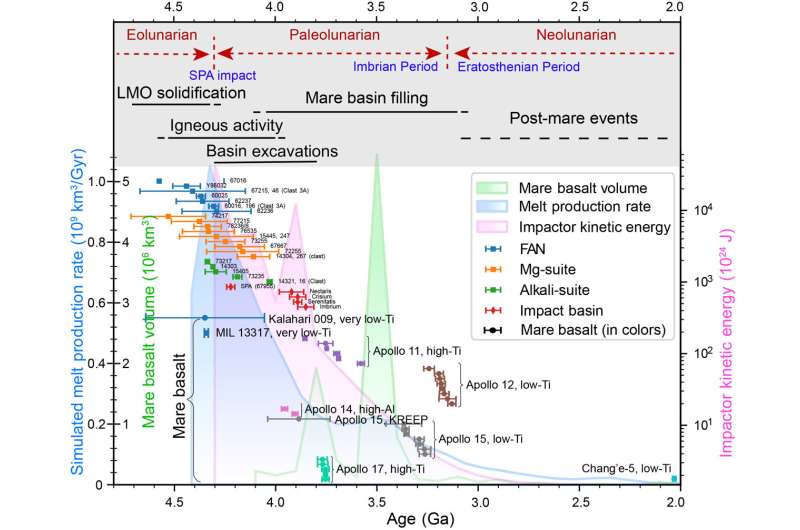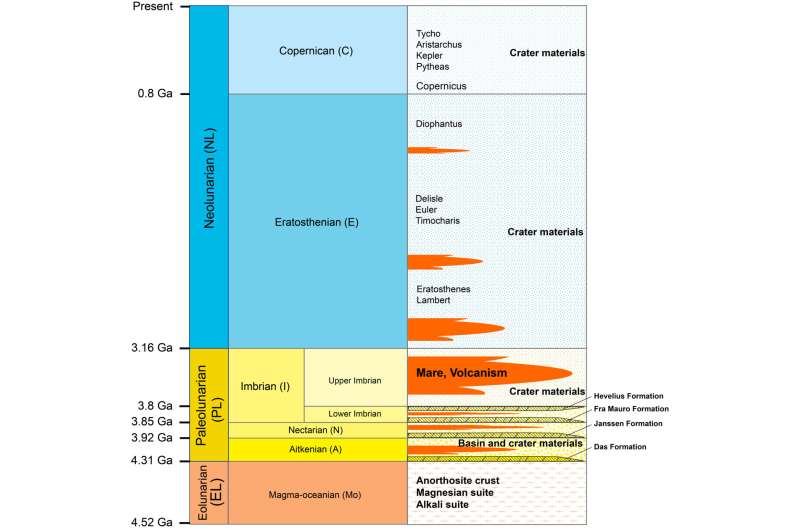This article has been reviewed according to Science X's editorial process and policies. Editors have highlighted the following attributes while ensuring the content's credibility:
fact-checked
peer-reviewed publication
trusted source
proofread
Scientists propose an updated time scale scheme of the Earth's moon

The moon's evolutionary history is divided into three distinct phases based on the temporal interplay of exogenic and endogenic processes in altering the moon. These phases are defined as Eon-level time scale units, which provide insights into the temporal dynamics of lunar evolution:
- The Eolunarian Eon (4.52–4.31 Ga), refers to magma ocean formation, differentiation and the solidification of the primary crust, a phase of evolution that largely involved endogenic forces and processes.
- The Paleolunarian Eon (4.31–3.16 Ga), characterized by comparable effects of endogenic and exogenic processes, including great impact events and significant volcanic activities.
- The Neolunarian Eon (3.16 Ga–present), represents the era dominated by exogenic processes, characterized by reduced volcanic activities and the prevalence of impact events in modifying the lunar surface.
A study led by Dr. Dijun Guo (National Space Science Center, Chinese Academy of Sciences), Dr. Jianhzong Liu (Institute of Geochemistry, Chinese Academy of Sciences), and Dr. James W Head (Brown University), has identified the ejecta stratum of the South Pole-Aitken Basin and named it "Das Formation." The work is published in the journal Science China Earth Sciences.
As the oldest stratum resulting from exogenic processes within the lunar crust, the Das Formation serves as the boundary between the Eolunarian and Paleolunarian Eons. By utilizing the Das Formation as a marker, the previously defined Pre-Nectarian Period is further divided into two distinct periods: the early Magma-oceanian Period and the relatively later Aitkenian Period.

The newly proposed lunar time scale scheme, consisting of three Eons and six Periods units, offers a systematic framework for describing the evolutionary history of the moon. This scheme effectively illustrates the advantages of expressing the progression, development, and transformation of both endogenic and exogenic processes that have taken place on the moon.
The scheme has been applied in the 1:2.5 million-scale lunar global geologic map compiled by the same group, and it holds significant implications for studying the geological evolution of other terrestrial planets.
More information: Dijun Guo et al, A lunar time scale from the perspective of the Moon's dynamic evolution, Science China Earth Sciences (2023). DOI: 10.1007/s11430-022-1183-4
Journal information: Science China Earth Sciences
Provided by Science China Press



















